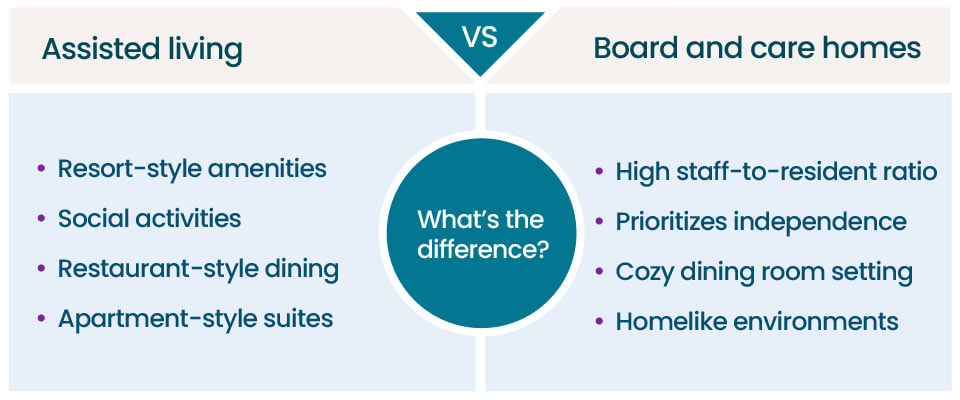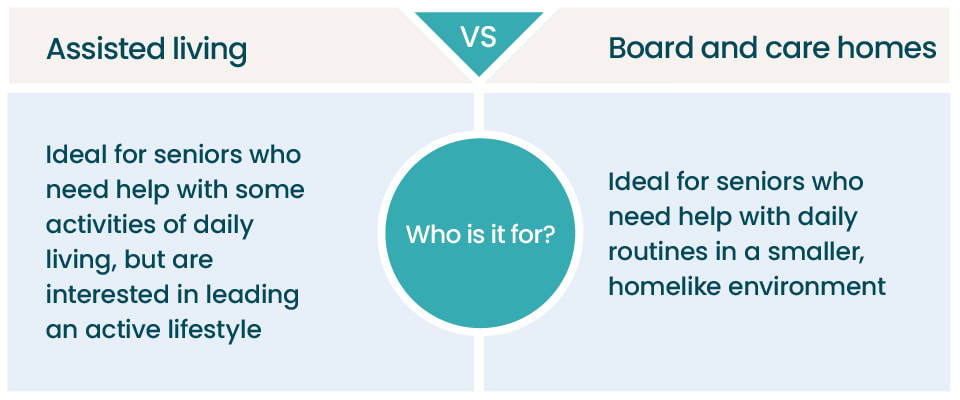
Assisted Living vs. Board and Care Homes for Seniors: What’s the Difference?

Assisted living communities and residential care homes provide similar services, but their environments are different. Assisted living communities typically have more than 25 residents, while board and care homes for seniors have fewer than 10. While some assisted living communities offer 24-hour care and residential care homes typically don’t, the main differences between the two senior living types is in size and the breadth of amenities offered. Both options include help with grooming, toileting, and basic health monitoring. They also both provide daily meals and aid with mobility.
Let our care assessment guide you
Our free tool provides options, advice, and next steps based on your unique situation.
Key Takeaways
- Board and care homes are residential homes where small groups of seniors live. Caregivers in these homes provide assistance with activities of daily living, such as bathing and dressing.
- Assisted living communities are larger facilities. Seniors receive a similar level of care in assisted living communities as in a care home.
- Assisted living is more expensive than a board and care home. This is due to the added amenities, services, and activities in an assisted living facility.
- Board and care homes provide a higher staff-to-resident ratio. Most care homes have 10 or fewer residents, which is significantly lower than the number of residents in most assisted living communities.
What are board and care homes?
Board and care homes are houses in residential neighborhoods that are equipped and staffed to help people with their daily routines. Assistance is focused around activities of daily living, such as bathing, dressing, and other daily care needs. This type of assistance is considered nonmedical care, which is comparable to the care offered in assisted living. These homes typically house a small number of residents, usually between two and 10.
The amount of assistance board and care homes provide is similar to what you’d receive in assisted living. Generally, this means board and care homes have caregivers available to help residents throughout the day and night, if needed.
Board and care homes may be referred to as:
- Residential care homes
- Adult family care homes
- Group homes
- Senior group homes
- Adult foster care homes
- Personal care homes
In some regions, one term is more popular than the others. For example, in California, “board and care home” is a common term, while in North Carolina, you may hear “group home.” But don’t let all these names confuse you — they’re essentially the same concept.
State regulations and licensure vary from state to state. Before you choose a residential care home, it’s a good idea to understand your state’s licensing regulations, plus how oversight works. Some care homes offer additional care, depending on who the owner or operator is and how they’re licensed. For example, some care homes are run by people in the medical field, such as a nurse or therapist. Each home will vary a little in what care is available.
What is assisted living?
Assisted living provides ongoing assistance with activities of daily living in a facility-based, apartment-style setting.
While residents do have a private apartment, sometimes with a kitchenette, they can also take advantage of the many amenities available. Many assisted living residents enjoy restaurant-style dining alongside friends. There’s also a calendar of activities and events that residents can take advantage of, making it ideal for seniors interested in a social, active lifestyle. In addition to things like happy hours and holiday parties, many assisted living communities have clubs organized to suit the interests of the residents. Other common offerings include fitness classes, book clubs, and movie nights.
Because assisted living offers a similar level of care as a board and care home, it’s ideal for seniors who need help with daily tasks like bathing and dressing but don’t need ongoing medical care. Each state has its own way of regulating and licensing assisted living facilities, which will affect what care an assisted living facility can provide. As with care homes, assisted living facilities will vary in what care is available.

Is assisted living the right fit?
Let our free assessment guide you to the best senior living options, tailored to your needs.
How to compare costs of assisted living and care homes
While assisted living and care homes both provide similar levels of assistance, you’ll find some differences in cost. According to A Place for Mom’s 2024 proprietary data, the national median monthly cost of assisted living is $4,995 while the national median monthly cost of a care home is $4,500.[01]
For both, however, the price depends on location and other services offered. For instance, a community that offers dementia care will cost more, and a community in California will cost more than one in Kansas.
The following chart compares the actual costs paid by families for rent and added care services across different regions of the United States.[01]
| Care type | North central | Northeast | South central | Southeast | West Coast |
|---|---|---|---|---|---|
| Assisted living | $4,718 | $5,499 | $4,327 | $4,046 | $4,703 |
| Residential care home | $3,004 | $3,814 | $4,096 | $3,191 | $4,151 |
While board and care homes are lower in cost around the country, rates do vary based on location, as shown in the chart above. Real-estate values in the area, as well as the cost of living, can affect the actual cost.
Assisted living communities often charge a flat rate that covers many basic services, with additional fees for special services like cable and transportation. Assisted living costs depend on many factors, including the following:
- Size of apartment (a studio or a one- or two-bedroom apartment)
- Types of services needed
- Amenities offered (more expensive communities might include beauty salons, massage therapy, or private dining)
- Location of the community (states in the Northeast and on the West Coast usually are more expensive than those in the Midwest and Southeast)
Residential care home costs often depend on the following:
- Room privacy (a shared room costs less than a private room)
- Amenities offered as well as any added services
- Real estate values in the neighborhood
It’s worth noting that because care homes are usually owned and operated by very small businesses, they tend to have more lower-cost options than assisted living facilities. With only one or a handful of homes to care for, these smaller businesses may be more open to negotiations than larger corporations.

Assisted living questions? Get expert help
Tell us your care needs to receive personalized guidance from our advisors.
Differences between assisted living and care homes
Regardless of whether you’re considering an assisted living community or a care home, the best way to make sure your loved one will be happy is by touring.

A Place for Mom partners with assisted living communities and care homes across the country. The following chart shows services and amenities seniors may be interested in, as well as the percentage of our partner communities that offer it.[02]
| Service or amenity | Percentage of assisted living communities offering | Percentage of care homes offering |
|---|---|---|
| Activity director | 72% | 8% |
| Art classes | 66% | 14% |
| Barbecues or picnics | 74% | 29% |
| Brain fitness | 50% | 3% |
| Complimentary transportation | 71% | 42% |
| Doctor on call | 54% | 41% |
| Full medication management | 82% | 53% |
| Gardening club | 56% | 10% |
| Happy hour | 62% | 4% |
| Housekeeping | 80% | 35% |
| Indoor common areas | 94% | 70% |
| Intergenerational programs | 45% | 6% |
| Laundry services or dry cleaning | 76% | 33% |
| Live performances | 73% | 20% |
| Nutritionist/dietician | 42% | 5% |
| On-site activities | 94% | 72% |
| Outings or off-site activities | 80% | 45% |
| Room service | 60% | 20% |
| Stretching classes | 66% | 17% |
| Transportation at cost | 51% | 48% |
| Trivia games | 67% | 12% |
| Wine tasting | 46% | 3% |
A higher percentage of assisted living communities offer the services and amenities listed above, and it’s important to note that this is reflected in the cost. Assisted living communities cost more because of their added amenities.
When it comes to residential care homes, the benefits (homey environment, close relationship with caregivers) often aren’t easy to measure. This is why it’s important to tour these communities first to see if their ambience and environment is fitting.
How to choose between residential care homes and assisted living
Because these two senior living options provide similar care services, and the cost for both can be so dependent on location and level of care, deciding between assisted living and residential care homes may come down to personal preference.
Keep in mind that both assisted living and board and care homes often offer less care than nursing homes.

When is a board and care home the right fit for a loved one?
Board and care homes for seniors may be a better fit for seniors who:
- Prefer a cozy, intimate, and homelike environment
- Want a home with fewer residents, which allows for more interaction and attention from staff
- Need help with mobility
- Would enjoy a relaxed, unstructured environment
- Want the privacy of a bedroom without all the responsibilities of an entire apartment, such as housekeeping
Seniors and family members who are happy in the care home they’ve chosen report that it feels like home and often appreciate the personalization that comes with living in a small group.
“The owners, management, and staff are very attentive to [my dad’s] needs and make it feel like his home. Because it is only a 16 person facility, they are able to keep it very personal and also provide well above average meals, which is important to my dad,” says Kay Krenek in a review of Fairbanks Court Assisted Living, a board and care home in Houston, Texas.
Sue B. had similar things to say when reviewing Lakota Hills Senior Care in Federal Way, Washington. “My mother has been a resident of Lakota for a little over a year. She gets outstanding care from people who are very competent and most important extremely patient and caring. The [caregivers] treat the residents with respect and give them all the attention and care they require.”
When is assisted living the right fit for a loved one?
Assisted living communities are more like inclusive hotels for retirees and may be the right choice for seniors who:
- Are looking for a variety of dining options and menus as well as happy hours
- Would like to live in a suite or larger apartment
- Are looking for new friends or social activities
- Would enjoy outings to local stores, theaters, and museums
- Are currently in good health but know they’ll need more help soon
- Would prefer an active lifestyle but don’t have access to transportation
- Would prefer to live in faith-based community, such as Jewish assisted living options
When a community is a good fit, families and their loved ones often feel at peace. The staff members and amenities also lead to comfortable transition.
The Keeble family had this to say about Colonial Oaks at Leawood, an assisted living community in Leawood, Kansas: “My brothers and I are thrilled with our mother’s care. It is her home. From the front desk staff to activity staff, culinary staff, and nursing staff, we could not have chosen a better place for our mom. She has actually improved since living there. She is thriving.”
For Nina, whose mother lives at Sunrise at East 56th in New York, New York, activities played a large part in her family’s experience. “We moved my mom there about 6 months ago and we haven’t seen her this happy in a while. She is busy from sun up to sun down. The staff is beyond caring and wonderful. They are very attentive to all the residents and always have a smile on their face.”
How do I learn more about senior living options?
Senior living choices have expanded as the needs and expectations of older adults have changed over the past several decades. Figuring out the best option for your loved one’s needs is crucial for keeping them healthy, active, and safe. Personality can play a large role, too, when families decide between assisted living and residential care.
At no cost to you, our Senior Living Advisors can guide you through all the senior living options and help you find the right fit for your family. They’ll show you the options in your area that are best suited to your loved one’s needs and priorities.
A Place for Mom. (2024). A Place for Mom room pricing and fees.
A Place for Mom. (2024). A Place for Mom community amenities.
The information contained on this page is for informational purposes only and is not intended to constitute medical, legal or financial advice or create a professional relationship between A Place for Mom and the reader. Always seek the advice of your health care provider, attorney or financial advisor with respect to any particular matter, and do not act or refrain from acting on the basis of anything you have read on this site. Links to third-party websites are only for the convenience of the reader; A Place for Mom does not endorse the contents of the third-party sites.
Assisted living options tailored to your needs
Assisted living options tailored to your needs